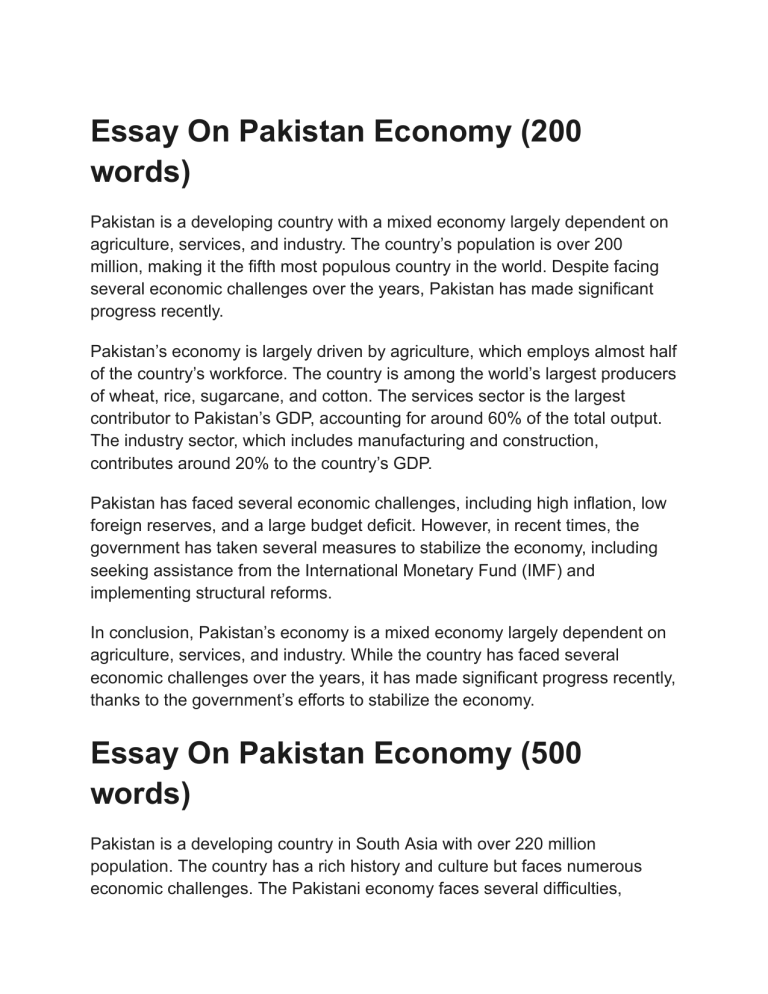
Essay On Pakistan Economy (200 words) Pakistan is a developing country with a mixed economy largely dependent on agriculture, services, and industry. The country’s population is over 200 million, making it the fifth most populous country in the world. Despite facing several economic challenges over the years, Pakistan has made significant progress recently. Pakistan’s economy is largely driven by agriculture, which employs almost half of the country’s workforce. The country is among the world’s largest producers of wheat, rice, sugarcane, and cotton. The services sector is the largest contributor to Pakistan’s GDP, accounting for around 60% of the total output. The industry sector, which includes manufacturing and construction, contributes around 20% to the country’s GDP. Pakistan has faced several economic challenges, including high inflation, low foreign reserves, and a large budget deficit. However, in recent times, the government has taken several measures to stabilize the economy, including seeking assistance from the International Monetary Fund (IMF) and implementing structural reforms. In conclusion, Pakistan’s economy is a mixed economy largely dependent on agriculture, services, and industry. While the country has faced several economic challenges over the years, it has made significant progress recently, thanks to the government’s efforts to stabilize the economy. Essay On Pakistan Economy (500 words) Pakistan is a developing country in South Asia with over 220 million population. The country has a rich history and culture but faces numerous economic challenges. The Pakistani economy faces several difficulties, including high unemployment, low literacy, political instability, and insufficient infrastructure. Despite these challenges, the country has made some progress in recent years. The Pakistan’s economy is heavily dependent on agriculture, which accounts for approximately 20% of the country’s GDP and employs around 43% of the workforce. The main crops include wheat, rice, sugarcane, and cotton. However, the sector faces several challenges, including water scarcity, lack of modern technology, and inadequate government policies. The government has recently launched several initiatives to improve the sector, such as the Kissan package, which aims to provide financial assistance to small farmers. The manufacturing sector is another significant contributor to the Pakistani economy, accounting for approximately 25% of the GDP. The country produces various goods, including textiles, cement, and fertilizer. However, the sector faces several challenges, including power outages, low productivity, and a lack of skilled labor. The government has launched several initiatives to improve the sector, such as the National Industrial Policy, which aims to provide incentives for investment in the manufacturing sector. The services sector is the most significant contributor to the Pakistani economy, accounting for approximately 55% of the GDP. The sector includes various industries, including banking, telecommunications, and retail. The government has launched several initiatives to promote the services sector, such as the Trade Development Authority of Pakistan, which aims to promote exports of services. Despite some progress, Pakistan’s economy faces several challenges, including a high inflation rate, a large budget deficit, and a high debt-to-GDP ratio. The government has launched several initiatives to address these challenges, such as the International Monetary Fund’s Extended Fund Facility program, which aims to provide financial assistance and support structural reforms. Another significant challenge facing the Pakistani economy is political instability. The country has faced several political crises recently, leading to a lack of policy continuity and investor uncertainty. The government has launched several initiatives to address this issue, such as the China-Pakistan Economic Corridor, which aims to improve connectivity between Pakistan and China and boost economic growth. In conclusion, Pakistan’s economy faces several challenges, including a high unemployment rate, low literacy rates, political instability, and insufficient infrastructure. However, the country has made some progress in recent years, particularly in the services and manufacturing sectors. The government has launched several initiatives to address these challenges, such as the Kissan package and the National Industrial Policy. Despite these efforts, Pakistan’s economy still has a long way to go before achieving sustained and inclusive economic growth.



